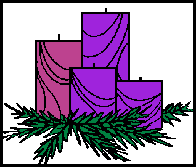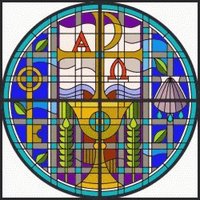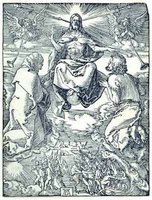Happy New Year!
Yes, “Happy New Year!” This coming Sunday is the First Sunday in Advent. That means that the Christian Church starts its annual calendar anew.
 What is Advent? “Advent” means appearance, approach, or coming. In churches that follow a special calendar called the “Liturgical Year” or “Church Year,” the new year begins on the First Sunday in Advent. Advent starts four Sundays before Christmas Day, (the Sunday closest to the Feast of St. Andrew the Apostle on 30 November).
What is Advent? “Advent” means appearance, approach, or coming. In churches that follow a special calendar called the “Liturgical Year” or “Church Year,” the new year begins on the First Sunday in Advent. Advent starts four Sundays before Christmas Day, (the Sunday closest to the Feast of St. Andrew the Apostle on 30 November).Advent is a time of preparation for the coming celebration of Christ’s birth and sober-minded anticipation of His return in judgment. Advent is also a time of reflection and repentance as we realize that it was our sinfulness that caused God to send our Savior into the world, to take our sins on Himself, and die on the cross.
The Church speaks of a “threefold advent” of Christ: 1) His lowly coming in the flesh, or incarnation, that Christmas celebrates (Zechariah 9:9; Luke 2:1-20); 2) His spiritual coming into the hearts of the believers and His constant presence in the Church (John 14:18-23); and 3) His return to judge the earth on the Last Day (Matthew 24:30).
 Advent is an excellent time to start or to enhance family devotions. Many fine booklets are offered; using them turns us away from some of the commercial excesses and crass abuses of the time preceding Christmas.
Advent is an excellent time to start or to enhance family devotions. Many fine booklets are offered; using them turns us away from some of the commercial excesses and crass abuses of the time preceding Christmas.Many homes use a four-candled wreath as part of their Advent devotions, lighting a new candle each week. In our tradition, the candles are usually three purple and one rose or else four blue. Purple signifies repentance (on our part) and royalty (of the coming Christ). Rose shows the dawn of heaven’s light. In an old tradition, it is used on the third Sunday as John the Baptist announces the coming of “the Lamb of God who takes away the sin of the world.” Blue commemorates God’s faithfulness to an unfaithful people and also is a traditional color for the Virgin Mary, Jesus’ mother.
Some families add a fifth (white) candle on Christmas Eve to celebrate the birth of the Savior of the Nations. If they desire to keep using the wreath during the Christmas season (through the Fifth of January), people often replace the four colored candles with white, which is “God’s color” of holiness. Using the wreath or colored candles in other arrangements during family devotions is one way of focusing attention on God and His Word, adding the benefit of attracting our children to this special time.
 In other parts of the world which use the wreath, the Advent candles may be different colors, including red. Also, while the custom began in the home, the Advent wreath has become a part of corporate worship in many Christian congregations.
In other parts of the world which use the wreath, the Advent candles may be different colors, including red. Also, while the custom began in the home, the Advent wreath has become a part of corporate worship in many Christian congregations.But enough of candles, let’s get back to the season: By now, you’ve seen countless Christmas advertisements, commercials, and store displays. Advertisements try to sell you anything under the sun, offering who-knows-what as “the perfect Christmas gift.” Is it any wonder that you feel burnt out and let down by the time Christmas arrives?
Observing the season of Advent is a Godly task, and a tonic against crass commercialism. For all of us who complain that time passes too quickly, Advent resets our focus. Why worry about how many shopping days are left before our credit cards are maxed out? Instead, we can learn anew that Christ is going to return in the flesh to raise the dead and to take all who believe in Him to heaven.
In other words, Advent reminds us that Christians already have our Christmas present: We are going to live with our Savior forever. We are already dead to sin through our baptisms, and alive in Christ eternally.
 Traditionally, Advent is not a time of bright, shining lights and glittering tinsel; that comes later as we enter into full and joyful celebration of Christmas. Indeed, I cherish each of the “twelve days,” which I may mention more in a later column. However, our celebration is always tempered by the times in which we live — times which may bring sadness even to the most devout believer.
Traditionally, Advent is not a time of bright, shining lights and glittering tinsel; that comes later as we enter into full and joyful celebration of Christmas. Indeed, I cherish each of the “twelve days,” which I may mention more in a later column. However, our celebration is always tempered by the times in which we live — times which may bring sadness even to the most devout believer.Most of all, however, the celebration is marred by our sinfulness. Advent’s time of preparation (for Christmas and for the Second Coming) thus is also a time of cleansing and renewal. It directs us to consider our entire relationship with God, with his people, and with the world at large. Small wonder that the message of John the Baptizer is also Advent’s central theme: “Prepare the way of the Lord, make his paths straight. (Luke 3:4)”
When we come to the Feast of the Nativity, we can truly have what the diet commercials only hollowly promise — guilt-free holiday dining. Our sins are taken away; our soiled garments are replaced with the robes washed white in the blood of the Lamb. We can sit down at the Lord’s banquet table (Holy Communion), anticipating the heavenly feast (of which Communion is the first course) and eat to our hearts’ content.
Scripture quoted from The Holy Bible, English Standard Version™, © 2001 by Crossway Bibles.
Send email to Ask the Pastor.
Walter Snyder is the pastor of Holy Cross Lutheran Church, Emma, Missouri and coauthor of the book What Do Lutherans Believe.

2 Comments:
As I understand history, Christmas Advent began in the Middle Ages. It was also greatly popularized (and modernized) by the "Advent Wreath" and "Advent Calendar," of much later invention in Germany.
Before that, for some time, possibly beginning in the sixth century or as early as the second, the liturgical "Advent" season was linked not to Christmas but rather to Epiphany which is when new Christians were often baptized. This Advent provided a period of 40 days to examine one's heart and do penance, which might explain why a "penitential" attitude is historically linked with Advent ...the original "forty days of purpose," you might say. :-)
When, in the 6th century, the RCC began linking Advent explicitly to the coming of Christ, it was still not the birth of Christ, but his Second Coming that the season of Advent anticipated. It was commonly called the "Lent of St. Martin" at that time, as Martin of Tours presided over the 597 Council of Tours, which prescribed a period of penitence for monks leading up to Christmas. In my understanding of the history, it was not until the middle ages that the church began using this Advent season to prepare to celebrate the twelve day feast of Christ's birth.
Here's a link worth looking at:
http://www.christianitytoday.com/ct/2002/147/52.0.html
The following source seems oblivious to the above distinctions:
http://www.internetpadre.com/christmas/history_of_advent.html
In any case, according to various sources, a Christmas "Advent" observed by the laity does not appear to have been a consistent practice throughout the centuries. Much of the time it existed since the sixth century it appears to have been a monastic practice.
CULTURALLY, this is currently a joyous anticipatory and preparatory period leading up to Christmas and the New Year - a season shared with all people, even pagans, regardless of their religious beliefs. As we engage the pluralistic culture we live in as a family, I play down the commercialized aspects of Christmas and keep the focus on Christ's coming.
The Christmas parade tonight in my town, with Santa Claus throwing out candy at the end, and with our church being open to members wanting to warm up with coffee and hot chocolate, caroling at the merchant's Christmas open house downtown, and various other events of the "Christmas season," including opening presents on Christmas morning, are not religious events, per se, but joyous cultural holiday events, much like other national holidays such as the one we just celebrated last Thursday and through the weekend. The current secular "Christmas" season, with all its trimmings, just happens to have its origins in the religious cultures of the earlier non-pluralistic societies of Europe (both pagan and Christian). What I have listed above now stand as our local cultural seasonal observations.
What we as a family RELIGIOUSLY observe (as non-unionistic, non-ecumenical Lutherans) currently are the Advent, Christmas Eve, and Christmas day services provided by my church, focusing our minds on the Christ of Christmas, followed by New Year's Eve service and the Christmas Sundays leading up to Epiphany. The teachings and means of grace provided at these times stay with us as we continue with our daily lives, sometimes engaged in the secular culture, and help keep our minds and attitudes focused on Christ, and the blessed meaning of the season.
Let me know if you think my understanding and/or our practice of this season should have any adjustments for the sake of my family.
Advent blessings to you!
Caspar
I think that what is right for your family is what is right for your family, Caspar. Whatever best prepares you and yours for the three-fold coming is what you "should" be doing.
As for the historical aspects, you have a good post hidden in my comments. I know that its observance varied widely among different areas of Lutheranism. A number of my members recall only Lent during the earlier years of their lives; Advent started being observed some time during the early- or mid-20th Century among many around here.
wps+
Post a Comment
<< Home